Analysis of the Occurrence Frequency of Seedable Clouds on the Korean Peninsula for Precipitation Enhancement Experiments
Abstract
1. Introduction
2. Materials and Methods
3. Results
4. Discussion
5. Conclusions
Author Contributions
Funding
Acknowledgments
Conflicts of Interest
References
- IPCC. Climate Change 2013: The Physical Science Basis. Contribution of Working Group I to the Fifth Assessment Report of the Intergovernmental Panel on Climate Change; Cambridge University Press: Cambridge, UK; New York, NY, USA, 2013; pp. 1–1535. [Google Scholar]
- WMO. Peer Review Report on Global Precipitation Enhancement Activities; WWRP 2018-1; WMO: Geneva, Switzerland, 2018; pp. 1–129. [Google Scholar]
- Kyoung, M.S.; Kim, H.S.; Sivakumar, B.; Singh, V.P.; Ahn, K.S. Dynamic characteristics of monthly rainfall in the Korean Peninsula under climate change. Stoch. Environ. Res. Risk Assess. 2011, 25, 613–625. [Google Scholar] [CrossRef]
- Choi, K.S.; Kim, D.W.; Byun, H.R. Possible impact of spring sea ice anomaly in the North Pacific on the Korean summer drought. Asia-Pac. J. Atmos. Sci. 2009, 45, 331–346. [Google Scholar]
- Barlow, M.; Cullen, H.; Lyon, B. Drought in central and southwest Asia: La Niña, the warm pool, and Indian Ocean precipitation. J. Clim. 2002, 15, 697–700. [Google Scholar] [CrossRef]
- Rao, V.B.; Giarolla, E.; Kayano, M.T.; Franchito, S.H. Is the recent increasing trend of rainfall over northeast Brazil related to sub-Saharan drought? J. Clim. 2006, 19, 4448–4453. [Google Scholar] [CrossRef][Green Version]
- Lee, C.; Chang, K.H.; Jung, J.W.; Cha, J.W.; Choi, Y.J.; Kim, K. Strategy for the meteorological and environmental airborne observations over the Korean Peninsula. Asia-Pac. J. Atmos. Sci. 2011, 47, 91–96. [Google Scholar] [CrossRef]
- Baik, J.; Choi, M. Spatio-temporal variability of remotely sensed precipitation data from COMS and TRMM: Case study of Korean peninsula in East Asia. Adv. Space Res. 2015, 56, 1125–1138. [Google Scholar] [CrossRef]
- Bruintjes, R.T. A review of cloud seeding experiments to enhance precipitation and some new prospects. Bull. Am. Meteorol. Soc. 1999, 80, 805–820. [Google Scholar] [CrossRef]
- Korneev, V.P.; Potapov, E.I.; Shchukin, G.G. Environmental aspects of cloud seeding. Russ. Meteorol. Hydrol. 2017, 42, 477–483. [Google Scholar] [CrossRef]
- Silverman, B.A. A critical assessment of glaciogenic seeding of convective clouds for rainfall enhancement. Bull. Am. Meteorol. Soc. 2001, 82, 903–924. [Google Scholar] [CrossRef]
- Griffith, D.A.; Solak, M.E. Economic feasibility assessment of winter cloud seeding in the Boise River drainage, Idaho. J. Weather Modif. 2018, 34, 39–46. [Google Scholar]
- Griffith, D.A.; Solak, M.E.; Yorty, D.P.; Brinkman, B. A level II weather modification feasibility study for winter snowpack augmentation in the Salt River and Wyoming ranges in Wyoming. J. Weather Modif. 2007, 39, 76–83. [Google Scholar]
- Bangsund, D.; Leistritz, F.L. Economic Impacts of Cloud Seeding on Agricultural Crops in North Dakota; Report for North Dakota Atmospheric Resource Board; NDSU: Bismarck, ND, USA, 2009; pp. 1–37. [Google Scholar]
- Ma, J.; Guo, X.; Zhao, C.; Zhang, Y.; Hu, Z. Recent progress in cloud physics research in China. Adv. Atmos. Sci. 2007, 24, 1121–1137. [Google Scholar] [CrossRef]
- Morrison, A.E.; Siems, S.T.; Manton, M.J.; Nazarov, A. On the analysis of a cloud seeding dataset over Tasmania. J. Appl. Meteorol. Climatol. 2009, 48, 1267–1280. [Google Scholar] [CrossRef]
- Manton, M.J.; Warren, L.; Kenyon, S.L.; Peace, A.D.; Bilish, S.P.; Kemsley, K. A confirmatory snowfall enhancement project in the snowy mountains of Australia. Part I: Project design and response variables. J. Appl. Meteorol. Climatol. 2011, 50, 1432–1447. [Google Scholar] [CrossRef]
- Manton, M.J.; Warren, L. A confirmatory snowfall enhancement project in the Snowy Mountains of Australia. Part II: Primary and associated analyses. J. Appl. Meteorol. Climatol. 2011, 50, 1448–1458. [Google Scholar] [CrossRef]
- Colorado Water Conservation Board (CWCB). Inventory and Assessment of Colorado Weather Modification Programs: A Summary of Current Programs and Opportunities for Enhancements; CWCB Reports; Colorado Water Conservation Board: Denver, CO, USA, 2015; pp. 1–300.
- Lee, C.; Chang, K.H.; Cha, J.W.; Jung, J.W.; Jeong, J.Y.; Yang, H.Y.; Seo, S.K.; Bae, J.Y.; Kang, S.Y.; Choi, Y.J.; et al. Estimation for the economic benefit of weather modification (Precipitation enhancement and fog dissipation). Atmosphere 2010, 20, 187–194, (In Korean with English abstract). [Google Scholar]
- Cha, J.W.; Jung, W.; Chae, S.; Ko, A.R.; Ro, Y.; Chang, K.H.; Seo, S.; Ha, J.C.; Park, D.; Hwang, H.J.; et al. Analysis of results and techniques about precipitation enhancement by aircraft seeding in Korea. Atmosphere 2019, 29, 481–499, (In Korean with English abstract). [Google Scholar]
- Guo, X.L.; Fu, D.H.; Li, X.Y.; Hu, Z.X.; Lei, H.C.; Xiao, H.; Hong, Y.C. Advances in cloud physics and weather modification in China. Adv. Atmos. Sci. 2015, 32, 230–249. [Google Scholar] [CrossRef]
- Seto, J.; Tomine, K.; Wakimizu, K.; Nishiyama, K. Artificial cloud seeding using liquid carbon dioxide: Comparisons of experimental data and numerical analyses. J. Appl. Meteorol. Climatol. 2011, 50, 1417–1431. [Google Scholar] [CrossRef]
- Chae, S.; Chang, K.H.; Seo, S.; Jeong, J.Y.; Kim, B.J.; Kim, C.K.; Yum, S.S.; Kim, J. Numerical Simulations of airborne glaciogenic cloud seeding using the WRF model with the modified morrison scheme over the Pyeongchang Region in the winter of 2016. Adv. Meteorol. 2018, 2018, 1–15. [Google Scholar] [CrossRef]
- Rosenfeld, D.; Yu, X.; Dai, J. Satellite-retrieved microstructure of AgI seeding tracks in supercooled layer clouds. J. Appl. Meteorol. 2005, 44, 760–767. [Google Scholar] [CrossRef]
- Geerts, B.; Pokharel, B.; Kristovich, D.A. Blowing snow as a natural glaciogenic cloud seeding mechanism. Mon. Weather Rev. 2015, 143, 5017–5033. [Google Scholar] [CrossRef]
- Tessendorf, S.A.; French, J.R.; Friedrich, K.; Geerts, B.; Rauber, R.M.; Rasmussen, R.M.; Xue, L.; Ikeda, K.; Blestrud, D.R.; Kunker, M.L.; et al. A transformational approach to winter orographic weather modification research: The SNOWIE Project. Bull. Am. Meteorol. Soc. 2019, 100, 71–92. [Google Scholar] [CrossRef]
- Koshida, T.; Murakami, M.; Yoshida, K.; Fujibe, F.; Takahashi, K. Assessment of clouds suitable for summertime precipitation augmentation over Shikoku Island. SOLA 2012, 8, 160–164. [Google Scholar] [CrossRef]
- Morrison, A.E.; Siems, S.T.; Manton, M.J. On a natural environment for glaciogenic cloud seeding. J. Appl. Meteorol. Climatol. 2013, 52, 1097–1104. [Google Scholar] [CrossRef]
- World Meteorological Organization (WMO). WMO Weather Modification Statement and Guidelines (updated in the ET meeting in Abu Dhabi. 22–24 March 2010). Available online: https://www.wmo.int/pages/prog/arep/wwrp/new/documents/WMR_documents.final_27_April_1.FINAL.pdf (accessed on 10 March 2020).
- Choi, Y.S.; Ho, C.H.; Ahn, M.H.; Kim, Y.M. An exploratory study of cloud remote sensing capabilities of the Communication, Ocean and Meteorological Satellite (COMS) Imagery. Int. J. Remote Sens. 2007, 28, 4715–4732. [Google Scholar] [CrossRef]
- Kim, H.D.; Kang, G.S.; Lee, D.K.; Jin, K.W.; Seo, S.B.; Oh, H.J.; Ryu, J.H.; Lambert, H.; Laine, I.; Meyer, P.; et al. COMS, the new eyes in the sky for geostationary remote sensing. Remote Sens.–Adv. Tech. Platf. 2012, 235–268. [Google Scholar] [CrossRef]
- Kim, B.Y.; Lee, K.T. Radiation Component Calculation and Energy Budget Analysis for the Korean Peninsula Region. Remote Sens. 2018, 10, 1147. [Google Scholar] [CrossRef]
- National Meteorology Satellite Center (NMSC). Algorithm Theoretical Basis Document for Cloud Amount; NMSC/SCI/ATBD/CA Issue 1, Rev. 4; National Meteorology Satellite Center: Beijing, China, 2012; pp. 1–22. [Google Scholar]
- Heidinger, A.K.; Evan, A.T.; Foster, M.J.; Walther, A. A naive Bayesian cloud-detection scheme derived from CALIPSO and applied within PATMOS-x. J. Appl. Meteorol. Climatol. 2012, 51, 1129–1144. [Google Scholar] [CrossRef]
- NIMS. Advanced Research on Applied Meteorology (II); No. 11-1360000-001128-10; Korea Meteorological Agency: Seoul, Korea, 2014; pp. 1–223, (In Korean with English abstract).
- Young, K.C. Microphysical Processes in Clouds; Oxford University Press: Oxford, UK, 1993; pp. 1–427. [Google Scholar]
- Guo, X.; Zheng, G. Advances in weather modification from 1997 to 2007 in China. Adv. Atmos. Sci. 2009, 26, 240–252. [Google Scholar] [CrossRef]
- Orville, H.D. A review of cloud modeling in weather modification. Bull. Am. Meteorol. Soc. 1996, 77, 1535–1556. [Google Scholar] [CrossRef]
- Woodley, W.L.; Rosenfeld, D.; Silverman, B.A. Results of on-top glaciogenic cloud seeding in Thailand. Part I: The demonstration experiment. J. Appl. Meteorol. 2003, 42, 920–938. [Google Scholar] [CrossRef]
- Rosenfeld, D.; Axisa, D.; Woodley, W.L.; Lahav, R. A quest for effective hygroscopic cloud seeding. J. Appl. Meteorol. Climatol. 2010, 49, 1548–1562. [Google Scholar] [CrossRef]
- Rossow, W.B.; Schiffer, R.A. ISCCP cloud data products. Bull. Am. Meteorol. Soc. 1991, 72, 2–20. [Google Scholar] [CrossRef]
- National Meteorology Satellite Center (NMSC). Cloud Detection (CLD) Algorithm Theoretical Basis Document; NMSC/SCI/ATBD/CLD, Issue 1, Rev. 0; National Meteorology Satellite Center: Beijing, China, 2012; pp. 1–28. [Google Scholar]
- National Meteorology Satellite Center (NMSC). CP Algorithm Theoretical Basis Document; NMSC/SCI/ATBD/CP, Issue 1, Rev. 4; National Meteorology Satellite Center: Beijing, China, 2012; pp. 1–22. [Google Scholar]
- National Meteorology Satellite Center (NMSC). COT Algorithm Theoretical Basis Document; NMSC/SCI/ATBD/COT, Issue 1, Rev. 4; National Meteorology Satellite Center: Beijing, China, 2012; pp. 1–43. [Google Scholar]
- National Meteorology Satellite Center (NMSC). CTTP Algorithm Theoretical Basis Document; NMSC/SCI/ATBD/CTTP, Issue 1, Rev. 5; National Meteorology Satellite Center: Beijing, China, 2012; pp. 1–40. [Google Scholar]
- National Meteorology Satellite Center (NMSC). Rainfall Intensity (RI) Basis Document; NMSC/SCI/ATBD/RI, Issue 1, Rev. 0; National Meteorology Satellite Center: Beijing, China, 2012; pp. 1–22. [Google Scholar]
- Kim, B.Y.; Lee, K.T.; Jee, J.B.; Zo, I.S. Retrieval of outgoing longwave radiation at top-of-atmosphere using Himawari-8 AHI data. Remote Sens. Environ. 2018, 204, 498–508. [Google Scholar] [CrossRef]
- Lee, S.H.; Kim, B.Y.; Lee, K.T.; Zo, I.S.; Jung, H.S.; Rim, S.H. Retrieval of reflected shortwave radiation at the top of the atmosphere using Himawari-8/AHI data. Remote Sens. 2018, 10, 213. [Google Scholar] [CrossRef]
- Kim, B.Y.; Lee, K.T. Using the himawari-8 ahi multi-channel to improve the calculation accuracy of outgoing longwave radiation at the top of the atmosphere. Remote Sens. 2019, 11, 589. [Google Scholar] [CrossRef]
- Joiner, J.; Vasilkov, A.; Bhartia, P.K.; Wind, G.; Platnick, S.; Menzel, W.P. Detection of multilayer and vertically extended clouds using the A-Train sensors. Atmos. Meas. Tech. 2010, 3, 233–247. [Google Scholar] [CrossRef]
- Kim, C.K.; Yum, S.S.; Park, Y.S. A numerical study of winter orographic seeding experiments in Korea using the Weather Research and Forecasting model. Meteorol. Atmos. Phys. 2016, 128, 23–38. [Google Scholar] [CrossRef]
- Ito, J.; Niino, H. Atmospheric Kármán Vortex Shedding from Jeju Island, East China Sea: A Numerical Study. Mon. Weather Rev. 2016, 144, 139–148. [Google Scholar] [CrossRef]
- Houze, R.A., Jr. Orographic effects on precipitating clouds. Rev. Geophys. 2012, 50, 1–47. [Google Scholar] [CrossRef]
- Watson, C.D.; Lane, T.P. Further sensitivities of orographic precipitation to terrain geometry in idealized simulations. J. Atmos. Sci. 2014, 71, 3068–3089. [Google Scholar] [CrossRef]
- Geerts, B.; Yang, Y.; Rasmussen, R.; Haimov, S.; Pokharel, B. Snow growth and transport patterns in orographic storms as estimated from airborne vertical-plane dual Doppler radar data. Mon. Weather Rev. 2015, 143, 644–665. [Google Scholar] [CrossRef]
- French, J.R.; Friedrich, K.; Tessendorf, S.A.; Rauber, R.M.; Geerts, B.; Rasmussen, R.M.; Xue, L.; Kunkel, M.L.; Blestrud, D.R. Precipitation formation from orographic cloud seeding. Proc. Natl. Acad. Sci. USA 2018, 115, 1168–1173. [Google Scholar] [CrossRef] [PubMed]
- Jin, Y.; Rossow, W.B. Detection of cirrus overlapping low-level clouds. J. Geophys. Res. Atmos. 1997, 102, 1727–1737. [Google Scholar] [CrossRef]
- Cotton, W.D.; Pielke, R.A. Human Impacts on Weather and Climate, 2nd ed.; Cambridge University Press: Cambridge, UK, 2007; pp. 1–330. [Google Scholar]
- Yoshida, Y.; Murakami, M.; Kurumisawa, Y.; Kato, T.; Hashimoto, A.; Yamazaki, T.; Haneda, N. Evaluation of snow augmentation by cloud seeding for drought mitigation. J. Jpn. Soc. Hydrol. Water Resour. 2009, 22, 209–222. [Google Scholar] [CrossRef]
- Manton, M.J.; Peace, A.D.; Kemsley, K.; Kenyon, S.; Speirs, J.C.; Warren, L.; Denholm, J. Further analysis of a snowfall enhancement project in the snowy mountains of Australia. Atmos. Res. 2017, 193, 192–203. [Google Scholar] [CrossRef]
- Rasmussen, R.M.; Tessendorf, S.A.; Xue, L.; Weeks, C.; Ikeda, K.; Landolt, S.; Breed, D.; Deshler, T.; Lawrence, B. Evaluation of the Wyoming Weather Modification Pilot Project (WWMPP) using two approaches: Traditional statistics and ensemble modeling. J. Appl. Meteorol. Climatol. 2018, 57, 2639–2660. [Google Scholar] [CrossRef]
- Mulyana, E.; Bahri, S. Recent progress in precipitation enhancement research. In Proceedings of the International Symposium on Weather Modification, Tsukuba, Japan, 3–4 March 2011. [Google Scholar]
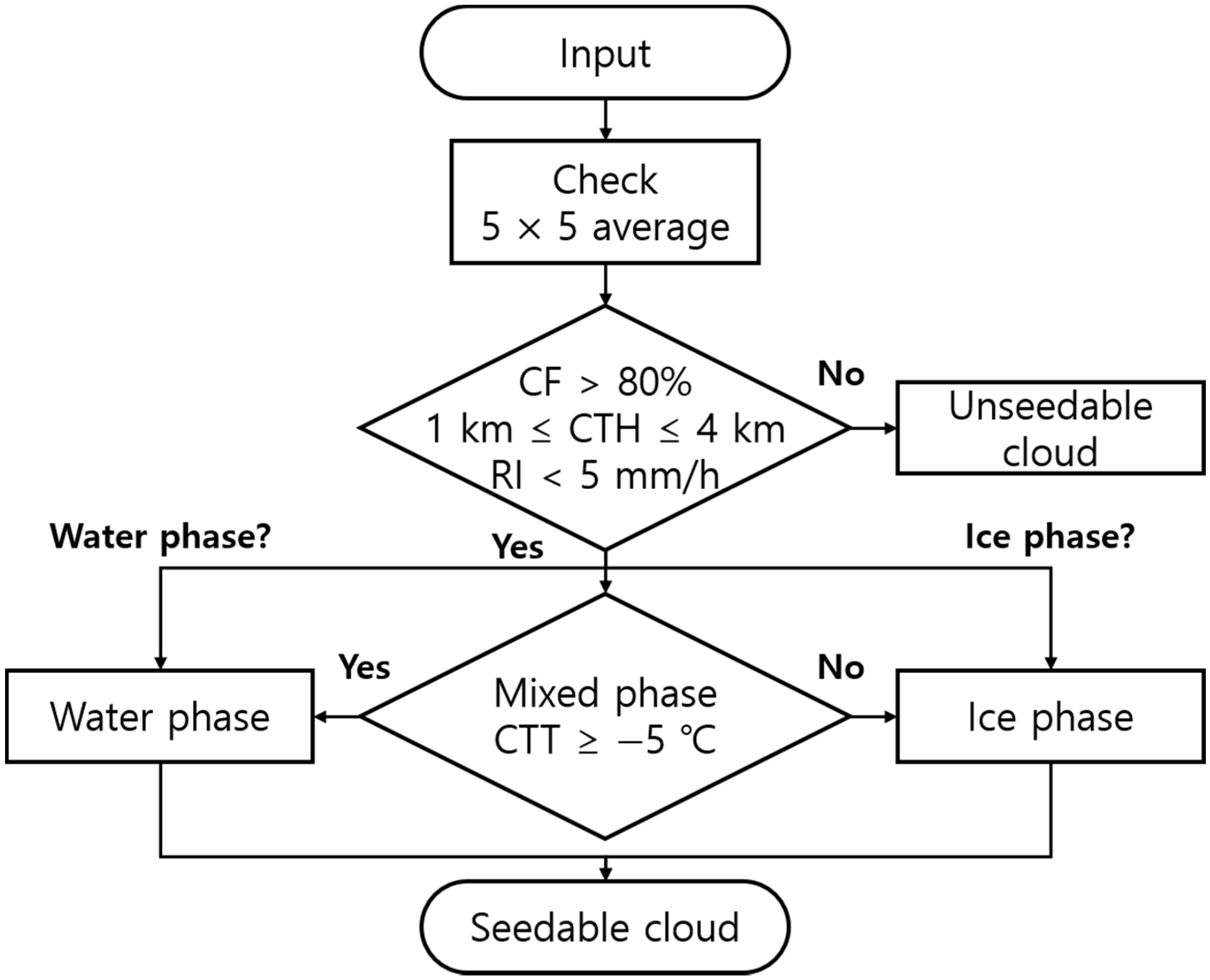
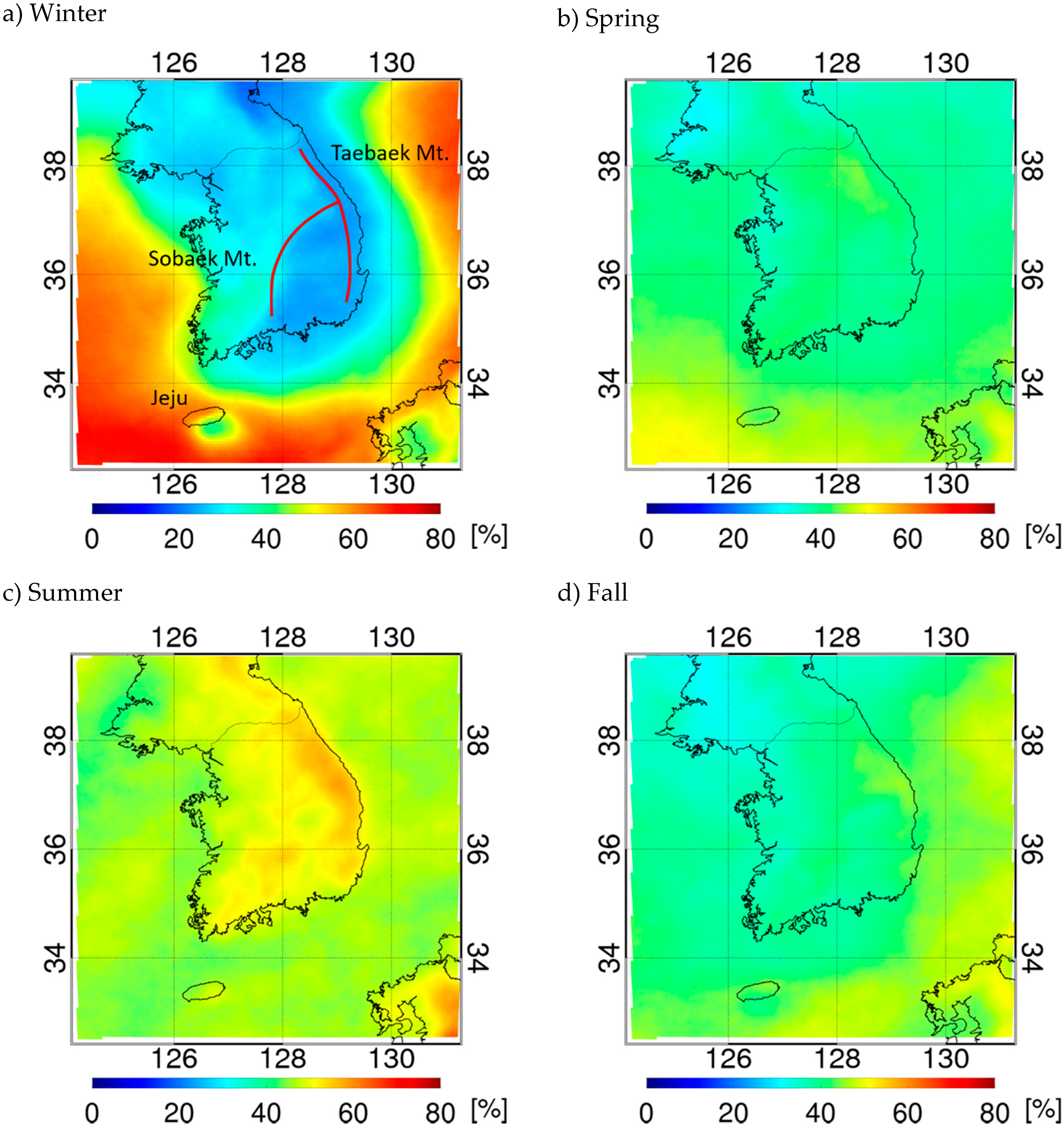
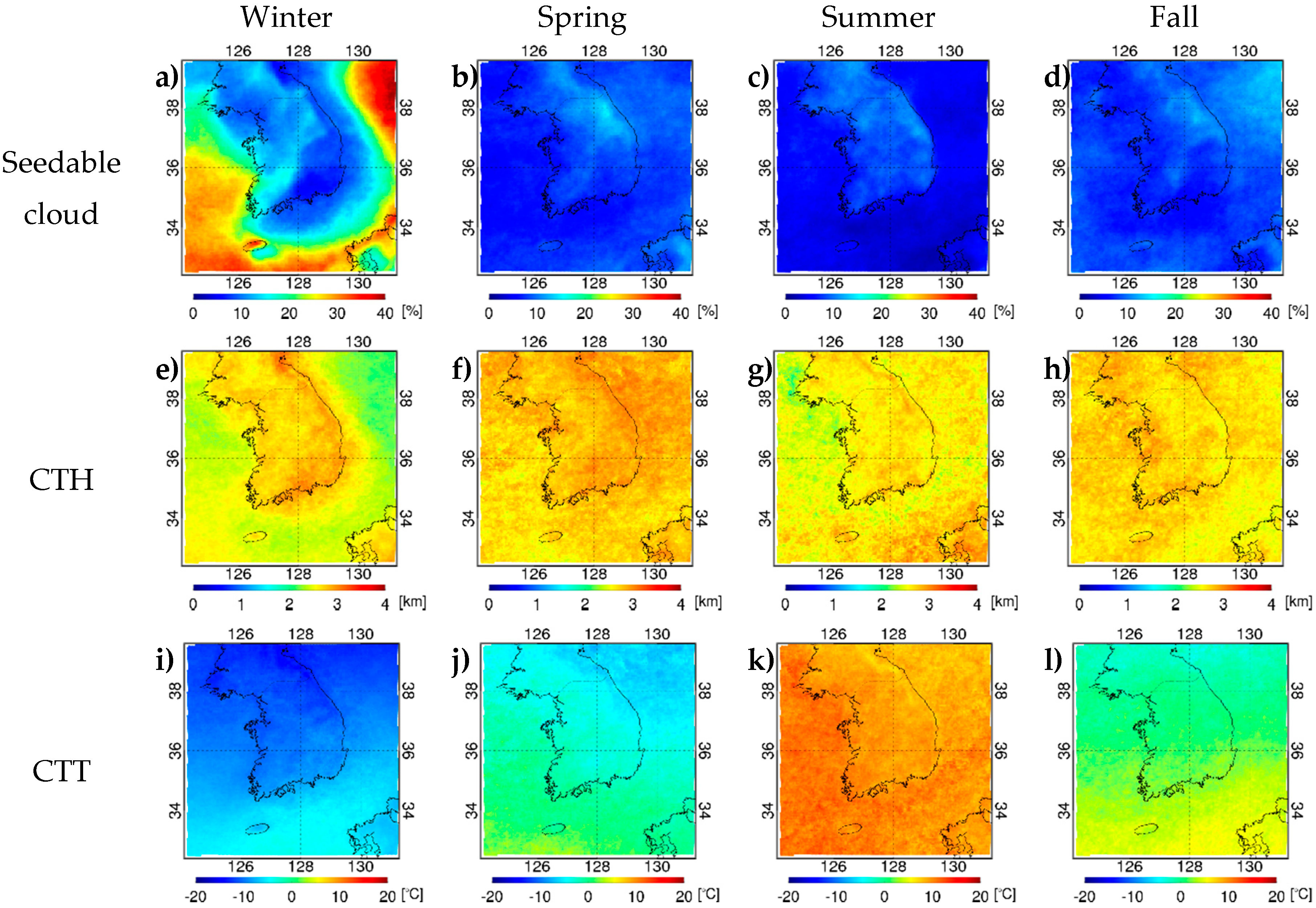
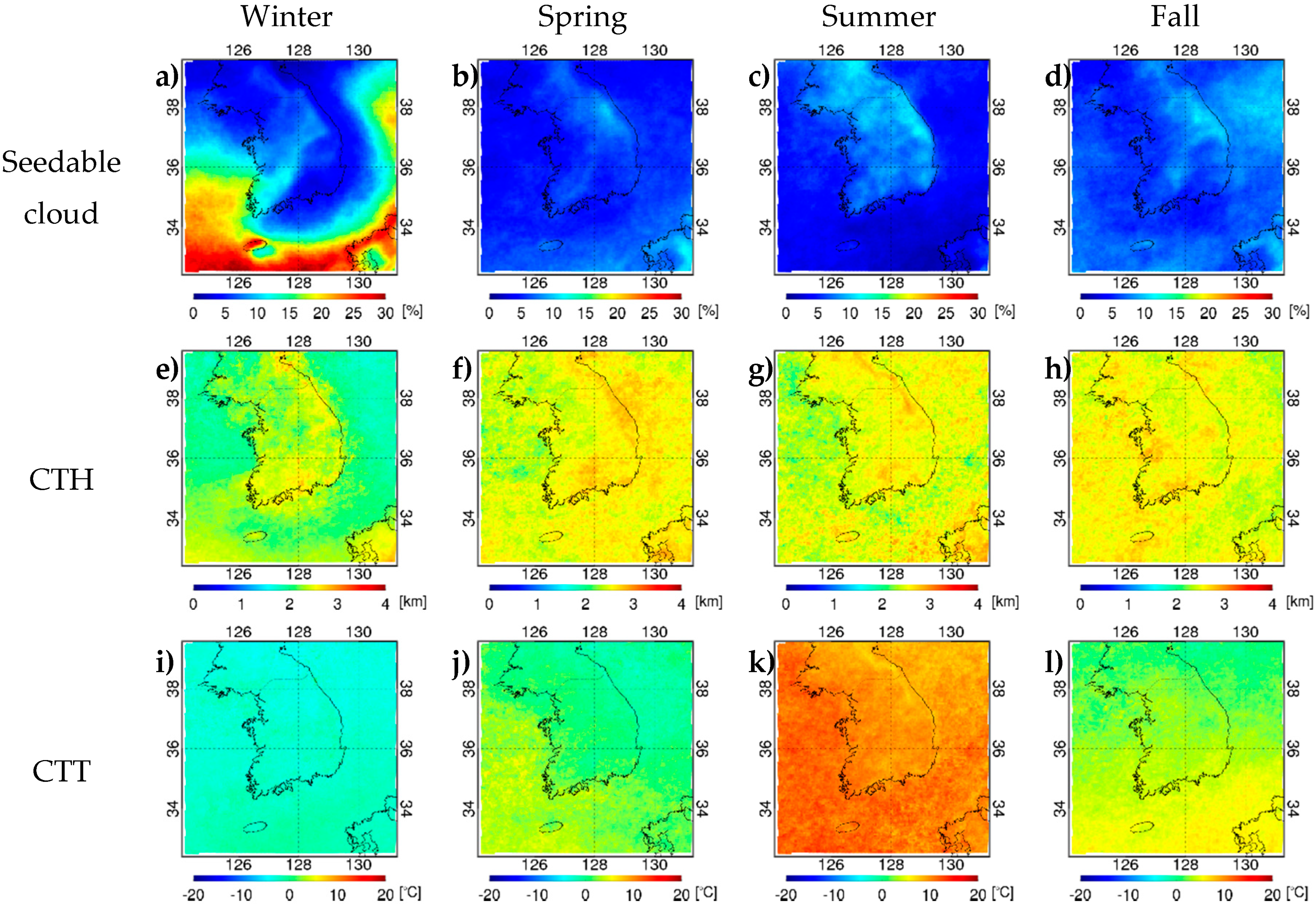
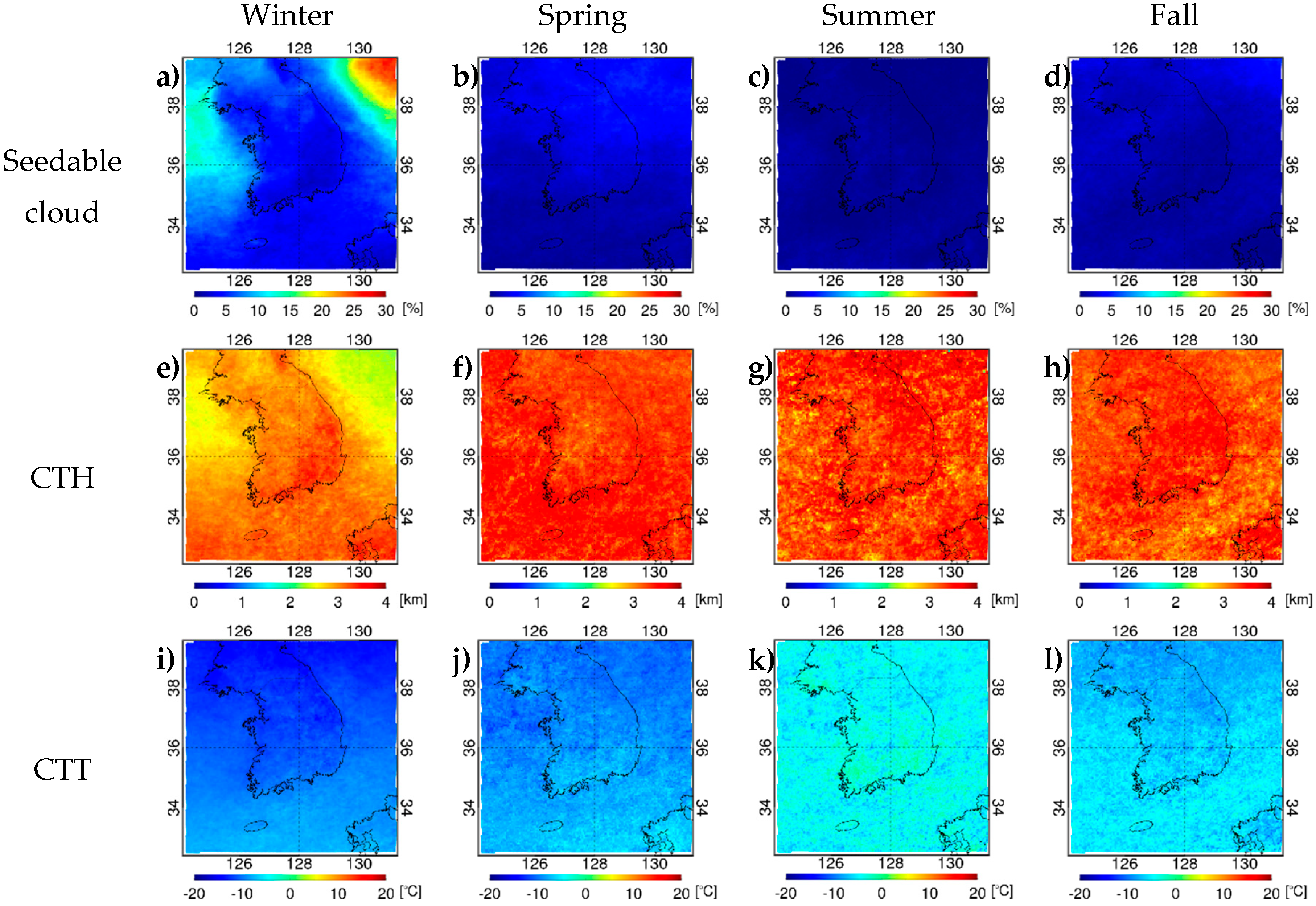
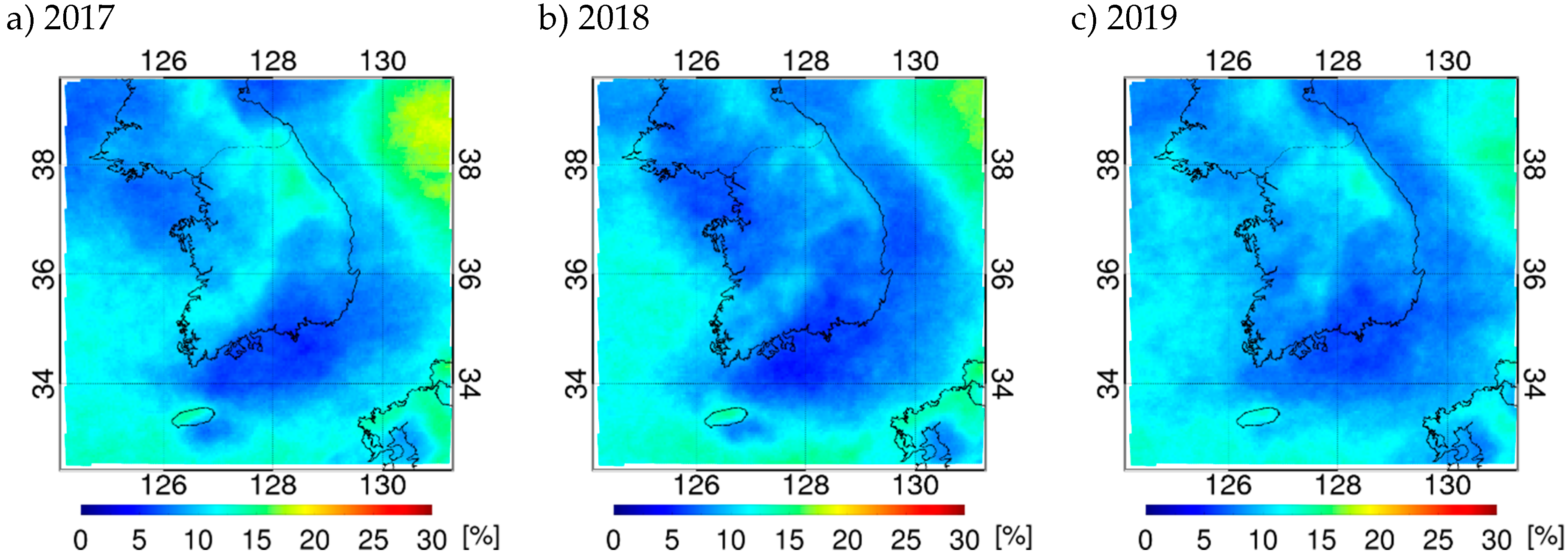
| Ac | As | Ns | Cu | Sc | St | N | ||
|---|---|---|---|---|---|---|---|---|
| Winter | Freq. | 5.04 | 15.04 | 0.03 | 17.44 | 62.39 | 0.07 | 2,037,643 |
| CTH | 3.36 | 3.13 | 3.35 | 2.40 | 2.25 | 2.37 | ||
| CTT | −11.48 | −7.89 | −6.67 | −7.72 | −7.33 | −6.05 | ||
| Spring | Freq. | 8.83 | 18.93 | 0.03 | 13.43 | 58.78 | <0.01 | 2,496,801 |
| CTH | 3.53 | 3.25 | 3.33 | 2.61 | 2.37 | 2.48 | ||
| CTT | −7.89 | −5.15 | −2.32 | −5.01 | −1.48 | −0.50 | ||
| Summer | Freq. | 4.84 | 11.48 | <0.01 | 13.36 | 70.32 | <0.01 | 2,270,728 |
| CTH | 3.55 | 3.24 | 2.74 | 2.48 | 2.31 | 2.36 | ||
| CTT | 5.56 | 6.15 | 10.97 | 10.78 | 11.29 | 14.74 | ||
| Fall | Freq. | 8.28 | 12.98 | 0.02 | 18.95 | 59.75 | 0.02 | 1,743,879 |
| CTH | 3.52 | 3.19 | 3.06 | 2.50 | 2.27 | 2.64 | ||
| CTT | −1.69 | −0.20 | −0.99 | 2.65 | 3.50 | −1.03 | ||
| Water Phase | Ice Phase | ||||||||||||||
|---|---|---|---|---|---|---|---|---|---|---|---|---|---|---|---|
| Ac | As | Ns | Cu | Sc | St | N | Ac | As | Ns | Cu | Sc | St | N | ||
| Winter | Freq. | 0.47 | 12.85 | 0.03 | 13.23 | 73.33 | 0.09 | 1,386,094 | 14.75 | 19.69 | 0.03 | 26.39 | 39.12 | 0.03 | 651,549 |
| CTH | 3.26 | 3.07 | 3.20 | 2.06 | 2.14 | 2.42 | 3.45 | 3.39 | 3.67 | 2.71 | 2.48 | 1.84 | |||
| CTT | −2.72 | −2.45 | −2.88 | −1.61 | −1.86 | −2.15 | −12.13 | −10.40 | −7.77 | −11.14 | −11.30 | −9.46 | |||
| Spring | Freq. | 2.84 | 16.99 | 0.04 | 10.13 | 70.01 | <0.01 | 1,792,845 | 24.08 | 23.87 | 0.01 | 21.86 | 30.18 | <0.01 | 703,956 |
| CTH | 3.54 | 3.22 | 3.33 | 2.29 | 2.26 | 2.47 | 3.58 | 3.49 | 3.63 | 2.94 | 2.76 | 3.19 | |||
| CTT | −2.22 | 0.25 | −1.46 | 0.84 | 2.95 | 3.94 | −10.31 | −11.29 | −8.88 | −10.22 | −11.26 | −6.28 | |||
| Summer | Freq. | 1.65 | 11.23 | <0.01 | 10.65 | 76.47 | <0.01 | 2,056,296 | 35.39 | 13.85 | - | 39.44 | 11.31 | - | 214,432 |
| CTH | 3.53 | 3.22 | 2.71 | 2.32 | 2.28 | 2.36 | 3.62 | 3.64 | - | 2.89 | 2.93 | - | |||
| CTT | 3.98 | 6.14 | 11.21 | 11.23 | 11.41 | 14.74 | −5.74 | −5.57 | - | −5.78 | −6.02 | - | |||
| Fall | Freq. | 4.32 | 12.13 | 0.02 | 16.43 | 67.09 | 0.02 | 1,497,370 | 32.31 | 18.18 | 0.02 | 34.27 | 15.20 | 0.03 | 246,509 |
| CTH | 3.51 | 3.15 | 3.04 | 2.36 | 2.22 | 2.58 | 3.63 | 3.58 | 3.56 | 2.84 | 2.85 | 3.07 | |||
| CTT | −0.05 | 2.62 | 2.83 | 3.75 | 5.31 | 3.40 | −7.91 | −8.65 | −11.73 | −8.30 | −9.54 | −9.17 | |||
© 2020 by the authors. Licensee MDPI, Basel, Switzerland. This article is an open access article distributed under the terms and conditions of the Creative Commons Attribution (CC BY) license (http://creativecommons.org/licenses/by/4.0/).
Share and Cite
Kim, B.-Y.; Cha, J.W.; Ko, A.-R.; Jung, W.; Ha, J.-C. Analysis of the Occurrence Frequency of Seedable Clouds on the Korean Peninsula for Precipitation Enhancement Experiments. Remote Sens. 2020, 12, 1487. https://doi.org/10.3390/rs12091487
Kim B-Y, Cha JW, Ko A-R, Jung W, Ha J-C. Analysis of the Occurrence Frequency of Seedable Clouds on the Korean Peninsula for Precipitation Enhancement Experiments. Remote Sensing. 2020; 12(9):1487. https://doi.org/10.3390/rs12091487
Chicago/Turabian StyleKim, Bu-Yo, Joo Wan Cha, A-Reum Ko, Woonseon Jung, and Jong-Chul Ha. 2020. "Analysis of the Occurrence Frequency of Seedable Clouds on the Korean Peninsula for Precipitation Enhancement Experiments" Remote Sensing 12, no. 9: 1487. https://doi.org/10.3390/rs12091487
APA StyleKim, B.-Y., Cha, J. W., Ko, A.-R., Jung, W., & Ha, J.-C. (2020). Analysis of the Occurrence Frequency of Seedable Clouds on the Korean Peninsula for Precipitation Enhancement Experiments. Remote Sensing, 12(9), 1487. https://doi.org/10.3390/rs12091487






